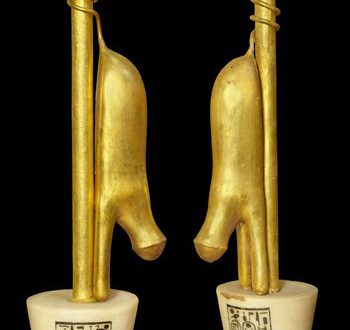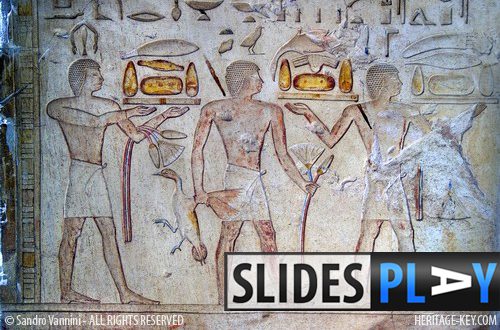 The Antechamber of the Tomb of Seti I (KV17) is a small room which precedes the burial chamber, and features on its tomb walls scenes depicted from the Book of the Dead. The renown photographer in the field of Egyptology, Sandro Vannini took several photographs throughout KV17, including the First Pillared Room which we featured recently. This week we look at the tomb engravings of the Antechamber, and who they depict.
The Antechamber of the Tomb of Seti I (KV17) is a small room which precedes the burial chamber, and features on its tomb walls scenes depicted from the Book of the Dead. The renown photographer in the field of Egyptology, Sandro Vannini took several photographs throughout KV17, including the First Pillared Room which we featured recently. This week we look at the tomb engravings of the Antechamber, and who they depict.
Sandro’s photography is the finest way to see Seti I’s tomb, after years of excavation have left it in a poor state of disrepair and leading to its closure to the general public. Sandro’s years of experience photographing the heritage of Ancient Egypt makes him the ideal man to send into the Tomb of Seti I to capture the beauty of one of the finest preserved tombs in the Valley of the Kings.
Heritage Key is working with Sandro to bring his fantastic photography onto the internet so you can enjoy it from the comfort of your own computer. You can also find out the latest from the excavation inside the tomb of Seti I in a video with the Director of the Supreme Council of Antiquities, Dr. Zahi Hawass. And if that’s not enough, then Dr Hawass and Sandro Vannini have a new book out looking at the Lost Tombs of Thebes, which is highly recommended reading material!
Sandro Vannini’s Photography
Sandro’s experience in photographing Ancient Egyptian antiquities gives him the necessary skills and knowledge to be able to capture some of the most valuable artefacts in the world, such as the Golden Mask of King Tutankhamun. In the Tomb of Seti I, Sandro used a Hasselblad ELD Ixpress 528C to capture the detailed engravings of the walls in the tomb’s antechamber. Despite the tomb’s closure, we can experience the magnificence of one of the Valley of the King’s finest tomb discoveries through the lens of Sandro Vannini.
The Antechamber of the Tomb of Seti I(KV17)
Discovered in 1817 by Giovanni Battista Belzoni, the Tomb of Seti I is the longest and deepest to have been found in the New Kingdom, at 136 metres and still counting. However, numerous excavations during the 1950s and 1960s caused walls to crack and even collapse due to changes in the moisture levels in the tomb walls.
The numerous chambers and passages in the Tomb of Seti I are shown in the above infomap. This week focuses on the Antechamber, which is the small room that precedes the burial chamber. The walls in the room are decorated with scenes of Seti I before various deities taken from the Book of the Dead. The lack of colour in these scenes is due to the large number of squeezes (pressed imprints) taken from the room, causing damage to the paintwork. The ceiling of the room is adorned with painted stars.
Don’t miss out on new treasures!
This post is part of a series focussing on amazing photographs from ancient Egypt. Keep checking back as well keep adding new images by Sandro Vannini. To make sure you don’t miss out on any of the updates, simply subscribe by email to receive notifications when new images are uploaded. For the more digitally advanced, there’s also an RSS feed with updates available.
See More Amazing Photography by Sandro
Have a look at some of the other stunning photographs by Sandro Vannini here at Heritage Key:
- Tomb of Seti I(KV17):First Pillared Room
- Tomb KV63 – Storage Room?
- King Tut’s Golden Throne
- Golden Mask of King Tutankhamun
Ask Sandro
We’ll be sitting down with our favourite photographer for an extended chat soon, so if you have any questions for Sandro we’ll send the answers straight to you!
King Seti I
King Seti I is displayed in the antechamber as a part of Spell 151, which would protect him from various dangers in the afterlife on his journey to the much sought-after Netherworld. The Book of the Dead was one of the most popular funerary texts used by New Kingdom Pharaohs on their tomb walls. Despite the effort that went into the planning of the tomb wall texts, the mummy of Seti I was not found resting in his tomb – instead it was found in the mummy cache of Tomb DB320 at Deir el-Bahri, from where it was moved to the Egyptian Museum, Cario.
Cutting the Foreleg
The cutting of the foreleg of a sacrificial ox was an important part of the funeral ceremony, which was essential for the Opening of the Mouth. The Opening of the Mouth is Spell 23 in the Book of the Dead, and would restore functionality to the mummy so the afterlife could be fully enjoyed. The purpose of the tomb was to act as a place of offerings and to be a platform for the Pharaoh to be able to enter the Netherworld.
The Iunmutef Priest
The Iunmutef priest were characteristic of royal temple mortuaries, and in this scene, represented the eldest son of the deceased King Seti I. Shown in the Tomb of King Seti I dressed in traditional panther skin and with a sidelock of youth, the Iunmutef priest was responsible for conducting the celebration of the funeral ceremonies in the proper manner. Amongst other duties, he attends to the purification and coronation ceremonies and the ritual of the Opening of the Mouth.
Isis
Isis was an Ancient Egyptian goddess who was idealised as the perfect mother and wife. On the Tomb walls of KV17, Seti I is portrayed as giving an offering of wine to the Isis in order to win her favour for a safe passage through the afterlife. Isis was considered to be the goddess of reincarnation and protector of the dead, and would allow Seti I free passage across the underworld of the afterlife.
Hathor
In the tomb KV17, Seti I is shown on the tomb wall being welcomed by the goddess Hathor. She was one of the most popular deities in Ancient Egypt, and was worshipped by numerous Pharaohs, as well as citizens. A goddess of music and dance, fertility and foreign lands, Hathor was the deity which welcomed the deceased into the next life, and for this reason her prominence in the Tomb of King Seti is important.
Movie: Dr Zahi Hawass and the Mysterious Tunnel in the Tomb ofSeti I (KV17)
Over the last two years, Dr Zahi Hawass has been leading a team excavating in the Tomb of Seti I, exploring a mysterious tunnel starting in the burial chamber. The purpose behind the tunnel and what it leads to is unknown, but Dr Hawass shares what he thinks could be there and updates the progress on the excavation on KV17.
You can see the transcript of the movie over on our Video Page, as well as seeing other fascinating films from the Valley of the Kings shot by Sandro in our weekly series. Additionally, you can find out more about Ancient Egypt on Heritage Key, as well as being able to explore the Valley of the Kings and the fascinating KV62 – King Tutankhamun’s tomb – in 3D in our exciting virtual experience! Also be sure to keep up to date on all new postings about Sandro’s photography from Egypt by subscribing to our feed, simply by entering your email address above.





